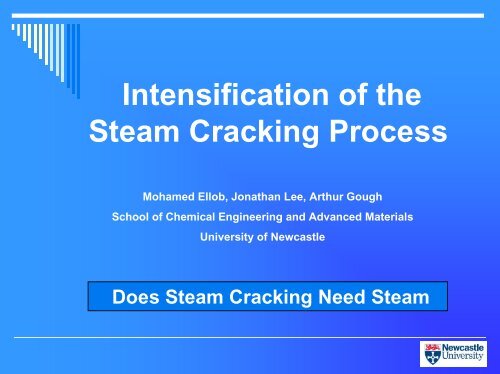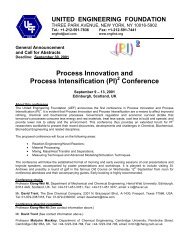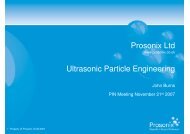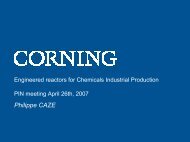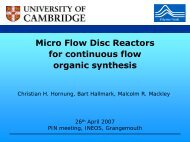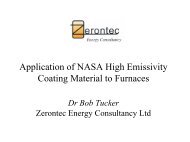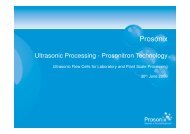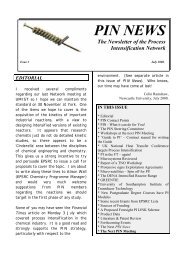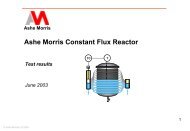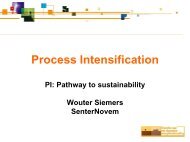Propane Cracking in a Micro Channel Reactor - Process ...
Propane Cracking in a Micro Channel Reactor - Process ...
Propane Cracking in a Micro Channel Reactor - Process ...
Create successful ePaper yourself
Turn your PDF publications into a flip-book with our unique Google optimized e-Paper software.
Intensification of the<br />
Steam <strong>Crack<strong>in</strong>g</strong> <strong>Process</strong><br />
Mohamed Ellob, Jonathan Lee, Arthur Gough<br />
School of Chemical Eng<strong>in</strong>eer<strong>in</strong>g and Advanced Materials<br />
University of Newcastle<br />
Does Steam <strong>Crack<strong>in</strong>g</strong> Need Steam
Presentation outl<strong>in</strong>e<br />
Introduction<br />
Catalytic plate reactors<br />
Coke formation<br />
Objectives<br />
Benefits<br />
Methodology<br />
Experimental Work<br />
Results<br />
Conclusions
Introduction<br />
Olef<strong>in</strong>s demand <strong>in</strong> year 2005 :<br />
Ethylene (107 million tons )<br />
propylene (67.1 million tons )<br />
Olef<strong>in</strong>s demand growth dur<strong>in</strong>g years(2005 –2010):<br />
Ethylene about 4.3% per year<br />
propylene about 5.4% per year<br />
Olef<strong>in</strong>s production capacity growth:<br />
Ethylene about 5.4% per year<br />
Propylene about 5.1% per year
Typical Steam <strong>Crack<strong>in</strong>g</strong> Furnaces<br />
Total Number of crack<strong>in</strong>g tubes about 600<br />
Total Reaction Volume about 45 m³<br />
Total firebox volume about 9,000 m³<br />
Residence Time 0.25 to 0.75 s<br />
Firebox Efficiency about 65%
Steam function and process limitation<br />
Enhance heat transfer<br />
Reduce coke formation and deposition<br />
Improve selectivity towards ethylene<br />
Operation purposes<br />
Coke deposition is the ma<strong>in</strong> process limitations<br />
due to:<br />
- High tube sk<strong>in</strong> temperature<br />
- High pressure drop
Exothermic<br />
channel gas<br />
Exothermic reaction<br />
catalyst<br />
Heat<br />
Th<strong>in</strong> plate<br />
Endothermic<br />
channel gas<br />
Endothermic reaction<br />
catalyst<br />
Catalytic Plate <strong>Reactor</strong>
Source: Velocys,(2005),olef<strong>in</strong>s by high <strong>in</strong>tensity oxidation, http: // www.velocys.com/Img/pdf.2250.pdf
Advantages Of Catalytic Plate <strong>Reactor</strong><br />
High Surface to volume Ratio<br />
Lam<strong>in</strong>ar flow Conditions<br />
High Heat transfer Coefficient<br />
Th<strong>in</strong> Catalyst Layer M<strong>in</strong>imize Diffusion Limitation<br />
Surface Temperature only few degrees above the<br />
process temperature<br />
Improved Safety and Environmental Impact<br />
Scale-up by Number<strong>in</strong>g –up<br />
Low Capital and operat<strong>in</strong>g Costs
Coke formation<br />
Metal-catalyzed coke<br />
Non-catalytic coke from tars<br />
Small chemical species (coke precursors) react<br />
with free radicals on the coke surface<br />
Heterogeneous Catalytic<br />
Heterogeneous non catalytic<br />
Homogeneous non catalytic<br />
Chemisorbed<br />
HC. Molecule<br />
Molecule<br />
Radical<br />
Coke particle<br />
Radical on coke surface<br />
Surface reaction<br />
Tar droplet
Objectives<br />
1-Study and <strong>in</strong>vestigate the possibility of <strong>in</strong>tensify<strong>in</strong>g the<br />
thermal crack<strong>in</strong>g of propane to produce ethylene through<br />
the use of the catalytic plate reactors.<br />
2- Reduc<strong>in</strong>g the coke formation and deposition.<br />
3- Reduc<strong>in</strong>g the use of steam.<br />
4- Modell<strong>in</strong>g and simulation for propane crack<strong>in</strong>g us<strong>in</strong>g<br />
Catalytic Plate <strong>Reactor</strong>.
Benefits<br />
Lower environmental and safety impacts.<br />
(NO x , contam<strong>in</strong>ated water, CO 2 , H 2 S)<br />
Improved energy efficiency.<br />
Lower capital cost.<br />
Improved overall plant economics
Experimental setup design criteria<br />
Allows for accurate coke measurement<br />
Constant and uniform temperature along the reactor<br />
Very fast cool<strong>in</strong>g of reaction products<br />
Easy to change reactor size and material
Nitrogen<br />
To CO2<br />
<strong>Propane</strong><br />
V-1 V-2 Filter-1<br />
FIC-1<br />
V-9<br />
V12<br />
V14<br />
analyser<br />
V-3 V-4 Filter-2<br />
FIC-2<br />
PI-1<br />
PI-2<br />
Air<br />
V13<br />
<strong>Reactor</strong><br />
V-5 V-6 Filter-3<br />
FIC-3<br />
Argon<br />
V-10<br />
V-7 V-8 Filter-4<br />
FIC-4<br />
Catchpot<br />
V15<br />
To GCs<br />
Catchpot<br />
V16<br />
<strong>Propane</strong> cracker<br />
show<strong>in</strong>g flow paths<br />
dur<strong>in</strong>g decoke<br />
Manometer<br />
Knock-out<br />
V17<br />
Vent
Experimental variables<br />
<strong>Reactor</strong> materials and <strong>in</strong>ternal coat<strong>in</strong>gs<br />
<strong>Reactor</strong> channel size<br />
<strong>Process</strong> variables ( temperature, pressure, and flow rate)<br />
Run time length
Conversion at low and high operat<strong>in</strong>g parameters<br />
Low flow rate<br />
10 0<br />
95<br />
90<br />
85<br />
80<br />
75<br />
70<br />
Conversion, %<br />
65<br />
60<br />
Temperature<br />
low<br />
high low<br />
high<br />
Pressure<br />
High flow rate<br />
100<br />
95<br />
90<br />
85<br />
80<br />
75<br />
70<br />
Conversion, %<br />
65<br />
Temperature<br />
60<br />
low<br />
high low<br />
high<br />
Pressure
Coke yield vs Flow at 835 o C and 1.35 bar<br />
Coke yield ( mg/g-propane reacted)<br />
1.2<br />
1<br />
0.8<br />
0.6<br />
0.4<br />
0.2<br />
0<br />
1.5 2 2.5 3 3.5 4 4.5 5<br />
Flow, l/h
Coke yield vs Temperature. at 3.5 l/h and 1.35 bar<br />
1.2<br />
Coke yield (mg/g-propane reacted)<br />
1<br />
0.8<br />
0.6<br />
0.4<br />
0.2<br />
810 820 830 840 850 860<br />
Temperature, o C
Coke yield vs Pressure at 3.5 l/h and 835 o C<br />
Coke yield (mg/g-propane reacted)<br />
1.1<br />
0.9<br />
0.7<br />
0.5<br />
0.3<br />
0.1<br />
0.9 1 1.1 1.2 1.3 1.4 1.5 1.6 1.7 1.8<br />
Pressure, bar
Coke yield at low and high operat<strong>in</strong>g parameters<br />
Low flow rate<br />
1.1<br />
1<br />
0.9<br />
0.8<br />
0.7<br />
0.6<br />
0.5<br />
0.4<br />
0.3<br />
0.2<br />
Coke yield (mg/g-propane reacted)<br />
Temperature<br />
Low<br />
High Low<br />
High<br />
pressure<br />
High flow rate<br />
0.6<br />
0.5<br />
0.4<br />
0.3<br />
0.2<br />
Low<br />
Coke yield (mg/g-propane reacted)<br />
Temperature<br />
High Low<br />
High<br />
pressure
Inlet of the reactor<br />
Middle of the reactor<br />
Outlet end of the reactor + Quench<strong>in</strong>g l<strong>in</strong>e
UY of Ethylene at low and high operat<strong>in</strong>g parameters<br />
Low flow rate<br />
50<br />
UY of Ethylene, Weight %<br />
48<br />
46<br />
44<br />
42<br />
40<br />
low<br />
Pressure<br />
high low<br />
High flow rate<br />
high<br />
Temperature<br />
Ultimate Yield =<br />
Mass Ethylene Produced<br />
Mass <strong>Propane</strong> In Feed<br />
Assum<strong>in</strong>g that the unreacted propane and<br />
the ethane produced by one pass through<br />
the reactor, are recycled to the feed<br />
50<br />
UY of Ethylene, Weight %<br />
48<br />
46<br />
44<br />
42<br />
40<br />
low<br />
Pressure<br />
high<br />
low<br />
high<br />
Temperature
Conclusions<br />
• Conversion of about 90 % can be achieved <strong>in</strong> 2 mm <strong>in</strong>ternal<br />
diameter fused silica reactor without any significant<br />
pressure drop.<br />
• Steam use can be reduced or possibly elim<strong>in</strong>ated.<br />
• High olef<strong>in</strong>s yield can be obta<strong>in</strong>ed without steam.<br />
• Low acetylene and C 4+ yield.<br />
• Run length of about 14 – 20 days was estimated to be<br />
possible before any decok<strong>in</strong>g is required. This run length<br />
was achieved with no steam.
THANK YOU


